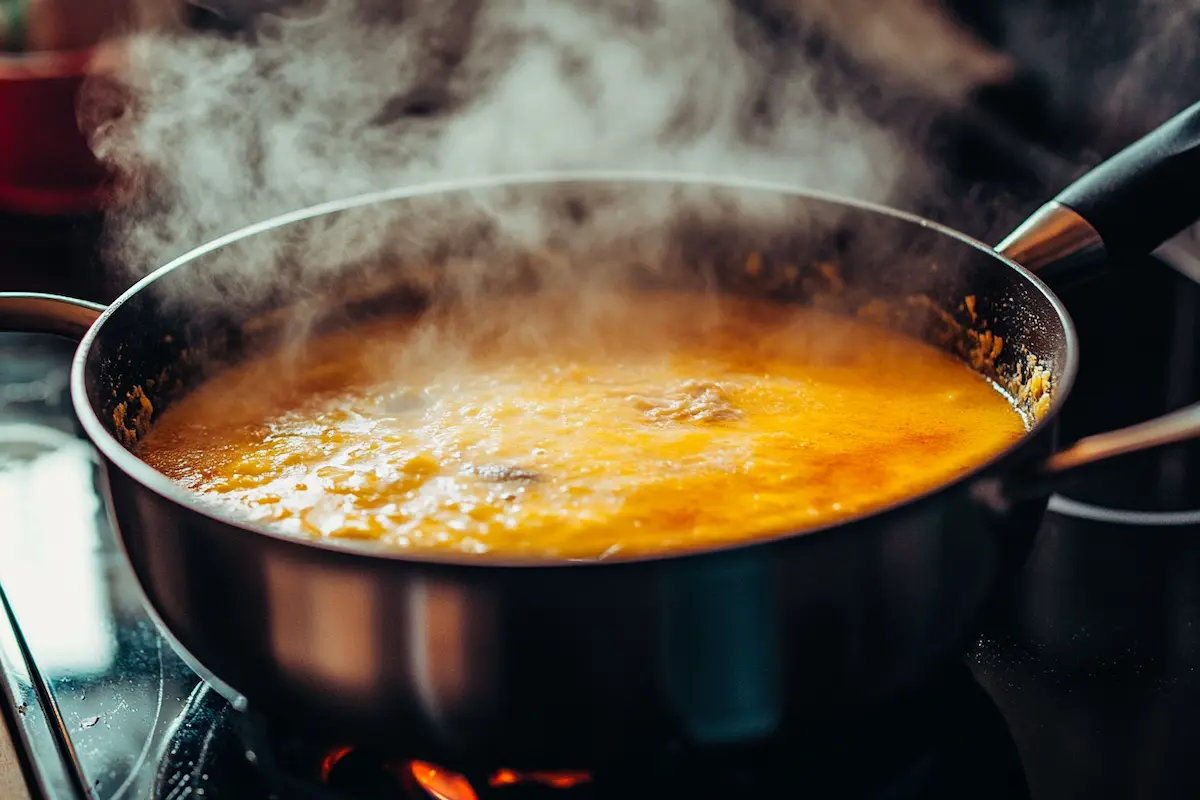Cream of squirrel soup might not be the first thing that comes to mind when thinking about comforting, creamy dishes, but this unique recipe brings history, flavor, and tradition to the table. Often cherished in rural and southern communities, this dish combines the earthy taste of wild game with the rich, hearty texture of a classic cream-based soup. Whether you’re curious about wild game cooking or looking to revive an old-fashioned recipe, this guide will walk you through everything you need to know, from its origins to serving suggestions.
1. What Is Cream of Squirrel Soup?
Cream of squirrel soup is a deliciously hearty dish that combines tender squirrel meat with a medley of vegetables, herbs, and cream. Rooted in tradition, this recipe showcases the ingenuity of early settlers who turned readily available ingredients into meals rich in flavor and sustenance.
1.1 Historical Roots of Squirrel-Based Soups
Squirrel dishes have long been staples in rural kitchens, especially in regions where hunting was a way of life. The practice of using wild game in soups is as old as time, reflecting a culture that wastes nothing and celebrates the natural bounty of the land. Creamy variations, however, add a luxurious twist to these traditional recipes.
1.2 Why Cream of Squirrel Soup Is Unique
Unlike other wild game soups, cream of squirrel soup strikes a delicate balance between the bold, slightly nutty taste of squirrel meat and the comforting richness of cream. It’s a dish that surprises and delights with its simplicity and depth of flavor.
1.3 The Role of Tradition in the Recipe
This dish is more than just a recipe—it’s a cultural emblem for many rural communities. Preparing cream of squirrel soup often brings families together, preserving memories and culinary skills passed down through generations.
2. Ingredients for Cream of Squirrel Soup
Making cream of squirrel soup starts with sourcing the right ingredients. Each element plays a vital role in creating a soup that’s both flavorful and comforting.
2.1 Key Ingredients You’ll Need
This recipe uses common kitchen staples and a few special additions to enhance the flavor. Here’s what you’ll need:
- Squirrel Meat: Tender, flavorful, and lean, squirrel meat is the star of the dish. Aim for young squirrels for a milder taste.
- Vegetables: A combination of carrots, celery, and onions adds sweetness and texture.
- Broth: A rich chicken or homemade squirrel broth forms the base.
- Cream: Adds velvety smoothness and richness.
- Seasonings: Salt, pepper, thyme, bay leaves, and parsley elevate the flavor.
- Butter and Flour: Create a roux to thicken the soup.
2.2 Tips for Sourcing Squirrel Meat
Squirrel meat can be tricky to find if you’re not a hunter. Farmers’ markets, specialty game meat suppliers, and ethical hunting are good options. If hunting, always adhere to local laws and guidelines.
2.3 Substitutions and Alternatives
If squirrel meat isn’t accessible, you can substitute with chicken, rabbit, or turkey for a similar texture and flavor. Vegetarians can use mushrooms for an earthy, hearty twist.
2.4 Ethical Considerations
Sourcing meat ethically is crucial. Sustainable hunting ensures minimal impact on wildlife populations and respects the environment. Always practice humane methods and avoid overhunting.
3. How to Make Cream of Squirrel Soup
Now that you have your ingredients ready, it’s time to bring everything together. Making cream of squirrel soup is a straightforward process that yields a comforting, hearty dish perfect for family meals.
3.1 Step-by-Step Recipe
3.1.1 Preparing the Squirrel Meat
- Clean and Dress the Squirrel: Remove fur, innards, and thoroughly wash the meat under cold water. Pat dry.
- Cut into Portions: Divide the squirrel into manageable pieces like legs, back, and ribs.
3.1.2 Cooking the Base
- Boil the Squirrel: In a large pot, add the squirrel pieces, bay leaves, and a pinch of salt. Cover with water or broth and bring to a boil. Reduce heat and simmer for about 1.5 hours, or until the meat is tender.
- Strain the Broth: Once the squirrel is cooked, strain and reserve the broth for later. Remove the meat from the bones and shred it.
3.1.3 Making the Roux
- Melt Butter: In a separate pot, melt butter over medium heat. Add flour and whisk constantly for 2-3 minutes to form a smooth paste.
- Add Broth Gradually: Slowly pour the reserved broth into the roux, whisking continuously to avoid lumps.
3.1.4 Assembling the Soup
- Add Vegetables: Stir in diced carrots, celery, and onions. Cook until tender, about 15 minutes.
- Incorporate Cream: Lower the heat and gently stir in the cream for a velvety texture.
- Combine with Squirrel Meat: Add the shredded squirrel meat back into the pot and season with thyme, parsley, salt, and pepper. Simmer for another 10 minutes.
3.2 Cooking Tips for Best Results
- Patience is Key: Slow cooking helps develop the rich, deep flavors in the soup.
- Don’t Skip the Roux: This step ensures the soup has a smooth, creamy texture.
- Adjust Seasonings Gradually: Taste as you go to achieve the perfect balance of flavors.
3.3 Variations for Different Preferences
- Spicy Kick: Add a pinch of cayenne pepper or smoked paprika.
- Vegetarian Alternative: Swap squirrel meat with hearty mushrooms and use vegetable broth.
- Thicker Consistency: Add more roux or simmer longer to reduce the liquid.
4. How to Serve Cream of Squirrel Soup
Presentation and pairing can transform cream of squirrel soup into a memorable dining experience. Whether serving it for a casual family meal or showcasing it as a unique dish at a gathering, the right accompaniments and touches matter.
4.1 Best Ways to Serve the Soup
4.1.1 Warm and Rustic Presentation
- Use Earthenware Bowls: The warm, earthy tones of traditional stoneware or rustic bowls enhance the comforting feel of the dish.
- Garnish Generously: Sprinkle fresh parsley or thyme on top for a pop of color and flavor.
4.1.2 Bread Pairings
- Rustic Bread: Thick slices of crusty bread are perfect for dipping.
- Buttery Biscuits: Flaky, buttery biscuits complement the creamy texture of the soup.
4.2 When to Serve Cream of Squirrel Soup
4.2.1 Seasonal Comfort
- Ideal for autumn or winter months when hearty meals are most appreciated.
- Great for outdoor gatherings where rustic flavors shine.
4.2.2 Family and Festive Occasions
- Perfect for family dinners or community events, where traditional and unique recipes are cherished.
4.3 Tips for Leftovers
- Storage: Store leftover soup in an airtight container in the refrigerator for up to 3 days.
- Reheating: Warm the soup gently over low heat, stirring frequently to avoid curdling.
- Freezing: While cream-based soups can be tricky to freeze, consider freezing the soup without the cream and adding it fresh when reheating.
5. Nutritional Value and Benefits of Cream of Squirrel Soup
Beyond its unique flavor and rich texture, cream of squirrel soup offers a surprisingly nutritious option for those exploring wild game dishes.
5.1 Nutritional Profile of Squirrel Meat
5.1.1 A Lean Protein Source
- High in Protein: Squirrel meat is an excellent source of lean protein, essential for muscle repair and energy.
- Low in Fat: Compared to other meats, it contains minimal fat, making it a healthier choice.
5.1.2 Rich in Micronutrients
- Iron and Zinc: Supports immune health and energy levels.
- B Vitamins: Contributes to brain function and cellular energy.
5.2 Benefits of Using Wild Game
5.2.1 Sustainability
- Squirrel meat is a sustainable choice for those who hunt responsibly or support local game meat suppliers.
5.2.2 Connection to Nature
- Incorporating wild game fosters a deeper appreciation for the outdoors and encourages mindful eating practices.
5.3 Cream’s Role in the Recipe
While the cream adds calories, it also contributes to the soup’s velvety texture and offers its own health benefits in moderation, such as calcium for bone health and fat for energy.
5.4 Comparing to Store-Bought Soups
- Lower Sodium: Homemade cream of squirrel soup has less sodium than canned varieties.
- No Preservatives: You control what goes into the soup, ensuring fresh and wholesome ingredients.
6. Cultural Significance of Cream of Squirrel Soup
This dish is more than a recipe; it’s a culinary tradition deeply rooted in rural heritage. Cream of squirrel soup reflects resourcefulness, family connections, and a respect for the land.
6.1 Historical Context
6.1.1 From Necessity to Tradition
In early rural America, using wild game like squirrels was a practical way to ensure families were well-fed. The ingredients were accessible, affordable, and sustainable. Over time, recipes like this evolved into cherished traditions passed down through generations.
6.1.2 Regional Variations
- Southern Influence: Creamy versions of squirrel soup are particularly beloved in the South, where cream-based dishes have a strong foothold.
- Midwestern Roots: In the Midwest, squirrel soups often focus on earthy flavors, with fewer creamy elements but a similar heartiness.
6.2 Modern Appeal
6.2.1 Revival of Heritage Recipes
There’s been a renewed interest in rustic, heritage dishes like cream of squirrel soup as people look to reconnect with traditional cooking. These recipes are seen as a way to preserve cultural identity.
6.2.2 A Unique Culinary Experience
For food enthusiasts, this dish offers a rare and adventurous dining opportunity. It appeals to those who enjoy exploring wild game and sustainable cooking practices.
6.3 The Dish’s Role in Family Gatherings
- Creating Memories: Cooking and eating cream of squirrel soup often becomes a bonding activity for families.
- Storytelling Over Dinner: Sharing tales of hunting and the origins of the recipe adds a layer of nostalgia to the meal.
7. Frequently Asked Questions About Cream of Squirrel Soup
This section addresses common inquiries about cream of squirrel soup, helping curious cooks and diners understand more about this unique dish.
7.1 Is squirrel meat safe to eat?
Yes, squirrel meat is safe to eat when properly prepared. It’s essential to ensure the meat is fresh, sourced responsibly, and thoroughly cooked to avoid potential parasites or contaminants.
7.2 What does squirrel meat taste like?
Squirrel meat has a mild, slightly nutty flavor similar to chicken or rabbit. Its taste is influenced by the squirrel’s diet, often reflecting the earthy, nutty tones of their natural habitat.
7.3 Where can I buy squirrel meat?
Squirrel meat is typically sourced through ethical hunting, but it can also be found at specialty butchers, wild game suppliers, or farmers’ markets in some regions.
7.4 Can I freeze leftover cream of squirrel soup?
Yes, but it’s best to freeze the soup without the cream. Add the cream during reheating to maintain the dish’s smooth texture and prevent separation.
7.5 Are there vegetarian alternatives to squirrel meat?
Absolutely! Mushrooms, lentils, or jackfruit can serve as substitutes. These options provide a hearty texture and absorb flavors beautifully, making them excellent for cream-based soups.
7.6 How do I ensure ethical hunting for squirrel meat?
Follow local hunting regulations, avoid overhunting, and use humane methods. Always respect the natural ecosystem and prioritize sustainability.
8. Conclusion
Cream of squirrel soup is more than just a dish; it’s a symbol of tradition, resourcefulness, and culinary creativity. From its roots in rural kitchens to its growing appeal among adventurous food lovers, this recipe brings together history, flavor, and sustainability in a bowl.
Whether you’re drawn to its rich, creamy texture, its nutritional benefits, or its connection to nature, this soup offers a unique way to enjoy wild game and explore a lesser-known side of traditional cooking. With proper preparation, care for sourcing, and a few cooking tips, you can create a dish that not only satisfies your appetite but also connects you to a long-standing culinary heritage.
Gather your ingredients, embrace the process, and savor the flavors of this rustic, comforting soup—perfect for warming both the body and soul.

